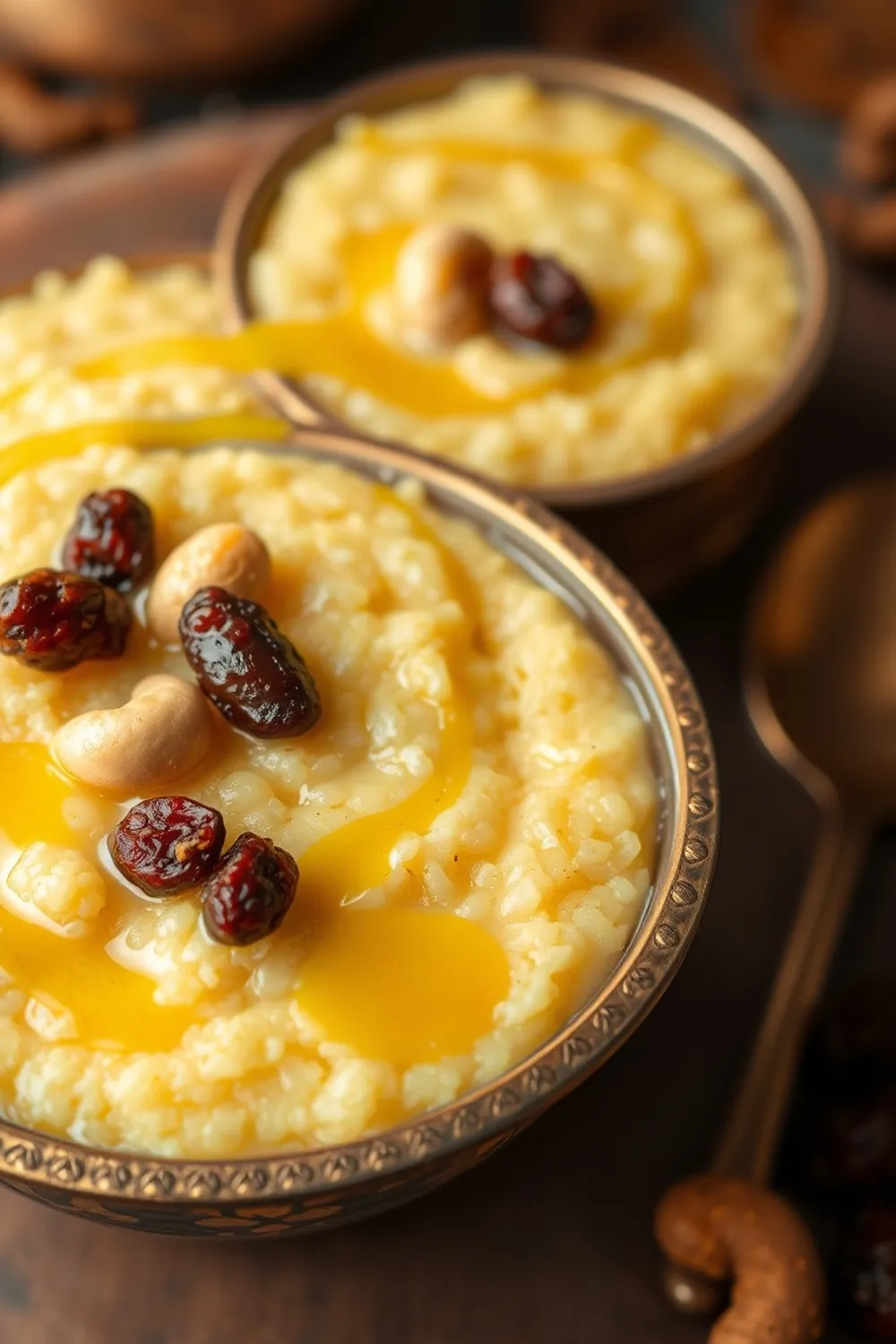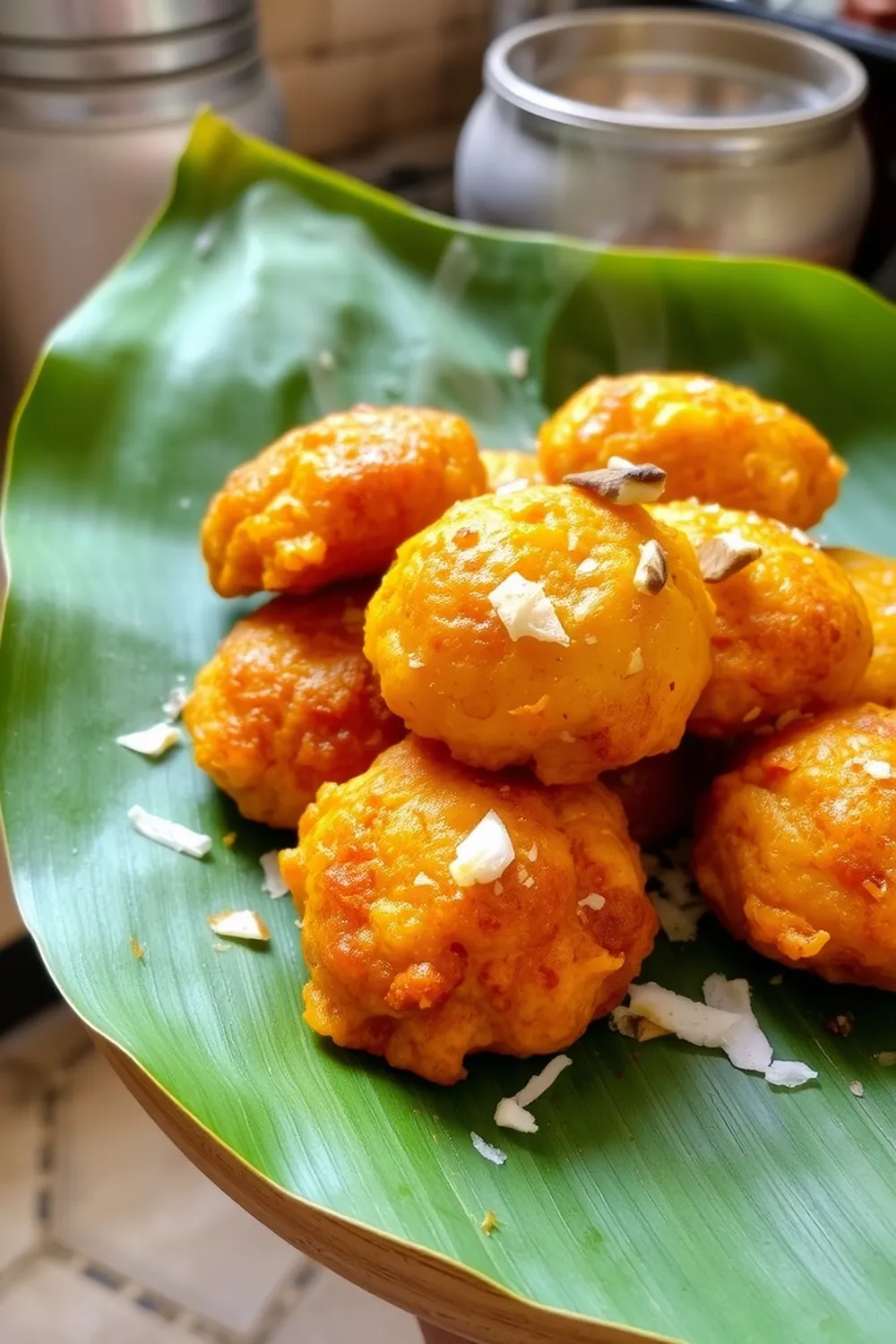- Soak sago pearls in water for at least 30 minutes.
- Combine one can (400ml) of coconut milk with 600 ml water in a saucepan. Heat on low flame until warm.
- Drain soaked sago and add to the saucepan. Cook on low heat, stirring frequently until the mixture thickens and the sago turns translucent.
- In a separate pan, heat 1 tsp ghee. Add chopped pineapple and 2-3 tbsp sugar. Cook until pineapple softens, mashing larger pieces.
- Add cooked pineapple and 1/2 can (200ml) condensed milk to the sago mixture. Stir well and simmer for 5 minutes.
- Pour in the remaining coconut milk, 1/2 tsp cardamom powder, and 1/4 tsp dry ginger powder. Cook for 2 minutes without boiling.
- Heat 3 tbsp ghee in a small pan. Fry cashews until golden brown, then add raisins until plump. Pour this garnish into the payasam and let it rest, covered, for 5-10 minutes.
- Serve warm or chilled. Adjust consistency with warm milk or water if it thickens upon cooling.
- Calories:320 kcal25%
- Energy:1338 kJ22%
- Protein:4 g28%
- Carbohydrates:45 mg40%
- Sugar:25 mg8%
- Salt:80 g25%
- Fat:18 g20%
Last Updated on 4 months by Neha Deshmukh
Pineapple Sago Payasam Recipe – Coconut Milk & Cardamom Dessert
Introduction
Oh, Payasam! Is there anything more comforting? This Pineapple Sago Payasam is a family favorite, and honestly, it’s the dessert I always gravitate towards during festivals or when I just need a little something sweet and special. It’s creamy, fragrant, and has the most delightful little bursts of pineapple. I first made this for my sister’s birthday, and it was a huge hit – I’ve been perfecting it ever since! Let’s get cooking, shall we?
Why You’ll Love This Recipe
This Pineapple Sago Payasam isn’t just delicious; it’s surprisingly easy to make. The combination of creamy coconut milk, sweet pineapple, and aromatic spices is simply divine. It’s a wonderful dessert to impress guests, or just to treat yourself. Plus, it’s a great way to use up that extra can of coconut milk you’ve been eyeing!
Ingredients
Here’s what you’ll need to create this delightful payasam:
- 0.5 cup sago pearls (sabudana)
- 2 cans (400 ml each) coconut milk
- 600 ml water
- 1 small pineapple
- 1 tsp ghee (clarified butter)
- 2 tbsp sugar
- 1 can (397 gm) condensed milk
- 0.75 tsp cardamom powder
- 0.5 tsp dry ginger powder (sonth)
- 3 tbsp ghee
- 15-20 cashew nuts
- 3 tbsp raisins
Ingredient Notes
Let’s talk ingredients! A few little tips can make all the difference.
Sago Pearls: Types and Soaking Tips
There are different types of sago pearls available. I prefer the smaller ones, as they cook more evenly. Always soak the sago pearls in water for at least 15 minutes before cooking. This helps them become soft and translucent.
Coconut Milk: Full-Fat vs. Low-Fat & Regional Variations
Full-fat coconut milk gives the richest, creamiest result. However, you can use low-fat if you prefer. In South India, they often use freshly squeezed coconut milk, which is amazing if you can get your hands on it!
Pineapple: Choosing the Right Pineapple for Payasam
A ripe, but not overripe, pineapple is best. You want it to be sweet and slightly tart. If using canned pineapple, make sure it’s packed in juice, not syrup.
Spices: The Significance of Cardamom and Dry Ginger (Sonth)
Cardamom (elaichi) and dry ginger (sonth) are essential for that classic payasam flavor. Cardamom adds a beautiful fragrance, while dry ginger provides a warm, subtle spice. Don’t skip them!
Ghee: Clarified Butter – Flavor and Health Benefits
Ghee adds a lovely richness and nutty flavor. It’s also considered very healthy in Ayurveda. You can substitute with vegetable oil if needed, but the flavor won’t be quite the same.
Step-By-Step Instructions
Alright, let’s get down to business!
- First, soak the sago pearls in water for 15 minutes. This is a crucial step, so don’t forget it!
- In a saucepan, combine one can of coconut milk with 600 ml of water. Heat on low flame until it’s just warm – we don’t want it boiling.
- Drain the soaked sago and add it to the saucepan. Cook on low heat, stirring occasionally, until the mixture thickens and the sago turns translucent. This usually takes about 15-20 minutes. Be patient!
- While the sago is cooking, let’s prepare the pineapple. In a separate pan, heat 1 tsp of ghee. Add the chopped pineapple and sugar. Cook until the pineapple softens, mashing the larger pieces with the back of a spoon.
- Add the cooked pineapple and condensed milk to the sago mixture. Stir well and simmer for about 5 minutes, allowing the flavors to meld.
- Pour in the remaining coconut milk, cardamom powder, and dry ginger powder. Cook for another 2 minutes, but don’t let it boil.
- Now for the garnish! Heat 3 tbsp ghee in a small pan. Fry the cashew nuts until they’re golden brown, then add the raisins and cook until they plump up. Pour this lovely mixture over the payasam.
- Let the payasam rest, covered, for about 5 minutes before serving. This allows the flavors to develop even further.
Expert Tips
A few little secrets to help you make the perfect payasam:
Achieving the Perfect Sago Texture
The key is low and slow cooking. Stir frequently to prevent sticking and ensure even cooking. You want the sago to be soft and translucent, but not mushy.
Preventing Payasam from Sticking or Burning
Use a heavy-bottomed saucepan and stir frequently, especially as the mixture thickens.
Balancing Sweetness and Spice
Adjust the sugar and spices to your liking. If you prefer a less sweet payasam, reduce the amount of condensed milk.
Using Fresh vs. Canned Pineapple
Fresh pineapple is fantastic, but canned works perfectly well too. Just make sure it’s packed in juice.
Adjusting Consistency for Warm vs. Chilled Serving
The payasam will thicken as it cools. If it becomes too thick, simply add a little warm water to reach your desired consistency.
Variations
Let’s get creative!
Vegan Pineapple Sago Payasam
Substitute the dairy coconut milk with a plant-based alternative, and use maple syrup or agave nectar instead of condensed milk.
Gluten-Free Pineapple Sago Payasam
This recipe is naturally gluten-free! Just double-check the labels of your ingredients to be sure.
Spice Level Adjustment: Increasing the Cardamom & Ginger
If you really love spice, feel free to add a little more cardamom and dry ginger. My grandmother always added a pinch of nutmeg too!
Festival Adaptations: Pongal & Onam Special
This payasam is perfect for Pongal and Onam. You can add a few strands of saffron for a festive touch.
Using Different Fruits: Mango or Apple Sago Payasam
Pineapple isn’t the only fruit that works well! Try using mango or apple for a different flavor profile. My friend loves making it with strawberries in the summer.
Serving Suggestions
Serve warm or chilled. A sprinkle of chopped nuts on top adds a nice crunch. It’s delicious on its own, or alongside other Indian sweets.
Storage Instructions
Store leftover payasam in an airtight container in the refrigerator for up to 3 days.
FAQs
Got questions? I’ve got answers!
What is Sago and is it Gluten-Free?
Sago is a starch extracted from the pith of sago palm stems. It’s naturally gluten-free, making it a great option for those with dietary restrictions.
Can I use fresh coconut milk instead of canned?
Absolutely! Freshly squeezed coconut milk will give you the most authentic flavor. You’ll need about 2 cups.
How do I prevent the sago from becoming mushy?
Soaking the sago properly and cooking it on low heat with frequent stirring are key.
Can this payasam be made ahead of time?
Yes, you can make it a day ahead. The flavors will actually develop even more overnight.
What is the best way to adjust the sweetness of the payasam?
Start with less condensed milk and add more to taste. You can also add a little sugar if needed.
Neha Deshmukh
Neha holds a B.A. in History with a focus on Indian and world history, including ancient, medieval, and modern periods. At RecipesOfIndia.org — the world’s largest database of Indian recipes — she combines her love for food and history by exploring how India’s past has shaped its culinary traditions.










